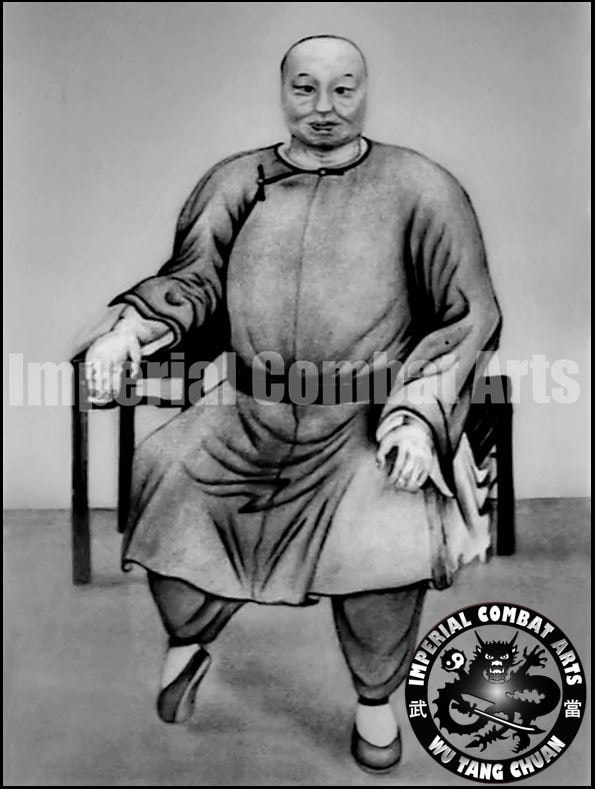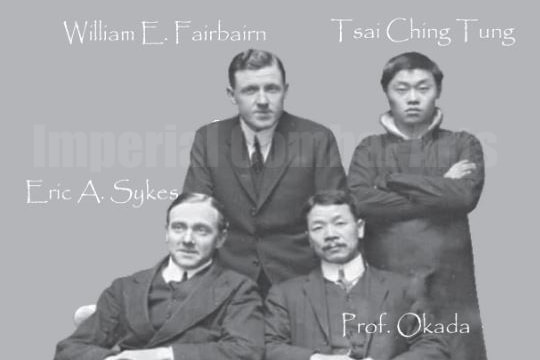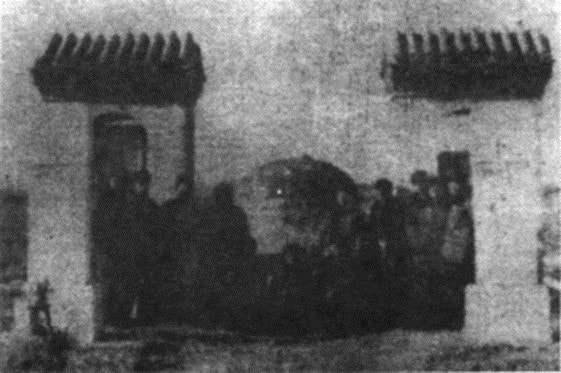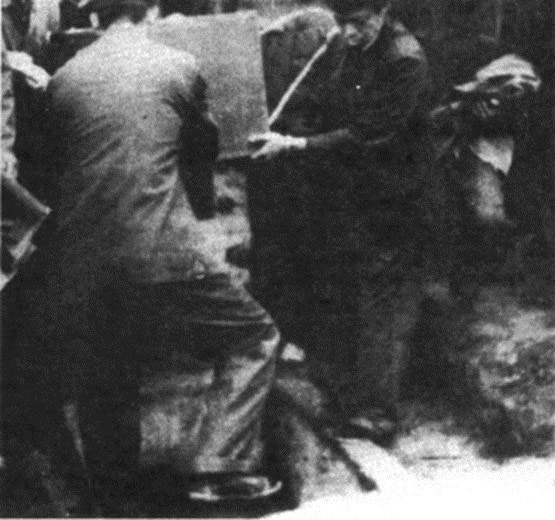TUNG HAI CHUAN
DONG HAICHUAN - 董海川 - DONG MINGKUI
|
Tung Hai Chuan (Dong Haichuan) was a highly skilled martial artist renowned for the development of Pakua Chang (The 8 Trigrams Palm), one of the primary Wu Tang Martial Arts taught today at Imperial Combat Arts. There are many tall tales and legends about Tung and his martial arts, but the historical truth is not hard to find and is a powerful story in itself. Fables of Tung Hai Chuan contain all manner of absurdities such as that he could walk on water, fly, teleport, was possessed by demons, he was a eunuch, he was an assassin for the South sent to kill the Hsien Feng Emperor, or that he actually learned his arts from Shaolin Buddhist Monks. To understand the true history of Tung we can start with his ancestor Tung Chun.
|
THE TUNG CLAN
Tung Chun (Dong Jun) 1186-1233 was the commander in charge of Kublai Khans military during the Mongolian conquest of China, and then the Marshal in charge of all military affairs in Kublai's pursuant Yuan Dynasty. The Tung family would live in the HungTung County of northern China's Shanxi Province for generations. With the fall of the Yuan, and rise of the Ming Dynasty, 1368, the Tung family moved to Gaocheng in Hebei. Tung Chun's descendants were Military Generals of record for six consecutive generations with the sixth being Tung Liang Fu. Tung Liang Fu would move his family to the town of Kai Kou (Kai Gou) in Hebei where they were known for five generations as Martial Arts Instructors. The fifth of these Instructors was Tung Jibei. Four generations later (15th generation descendant of Tung Jun, over half a century later), we have Tung Hsien Cho (Dong XuanZhou).
A book written in 1929 "The Local History, Xiong County Chronicles" speaks of the martial arts ability of Tung Hsien Cho as far exceeding those of others in his town, which was well known for its martial arts.
BIRTH OF TUNG HAI CHUAN
Tung Hai Chuan, whos name at birth was Tung Ming Kui (Dong Ming Que), was born in 1813 as the second son of Tung Po Hsuuan (Dong Bo Xuan) also in Hebei Provence. The Tung family surname literally means Instructor and Supervisor, and its important to note the families long history of warriors and martial arts teachers in the development of Pakua. Not only in martial arts knowledge passed down and refined for generations, but also in genetics. It has been very common for the Southern Chinese to alter history against those of Mongol and Manchu decent, as they were seen as foreign occupying forces from the north. Chinese calligraphy for the Mongol race 蒙, also means "Ignorant" and to "Suffer".
During the Ch'ing Dynasty what's know today as Hebei was still called Zhili Provence, and was the area directly surrounding the capital city of Beijing. Important to the defense of the Capital, Zhili was full of multi- generational warriors, military men, men-at-arms, and was well known for it's martial arts for centuries.
POWER OF TUNG HAI CHUAN
Tung Hai Chuan was a very strong, stocky man of Mongol decent described as having large hands, the strong back of a horse, outstanding stamina, and as one who excelled at martial arts since childhood. The Tung family trained traditional battlefield weapons such as Saber, as is evident in the vast array of military weapons used in combat Pakua. Pakua also trains with extremely large oversized weapons that take great strength to wield in battle, not to be mistaken for the lightweight mock versions of these weapons many use today in Pakua.
TUNG HAI CHUAN'S CHILDHOOD
Tung Hai Chuan would train martial arts during his childhood under his relative the famous aforementioned Tung Hsien Cho. Cho and Chuan were described as inseparable and often travelled between Xiongxian County and Wen'an to visit friends and train under other famous martial arts masters. Tung Hai Chuan was rarely seen at home and with any opportunity would run off to be with Tung Hsien Cho. We also know from his original grave marker, placed at the time of his death, that in youth Tung Hai Chuan had no interest in farming and spent his time riding his horse in the forest, hunting, exploring, and he traveled all over Mid and Western China to see the great natural sights, rivers, and mountains. It was during these travels he learned Taoist martial arts.
"he encountered a Taoist priest who taught him martial arts. Tung reached a high level of skill."
- Inscribed on Tung Hai Chuan's original grave marker.
- Inscribed on Tung Hai Chuan's original grave marker.
LEARNING TAOIST MARTIAL ARTS
There really is no great mystery to Tung Hai Chuan's study of Taoist Martial Arts. By this time in China's history Taoism had been around for well over 2,300 years. Teaching in Beijing later in life, Tung would work and train alongside other famous Taoist martial arts masters, some with martial lineages already between 600 to 1,400 years old. Pakua Chuan is by far the youngest of the Wu Tang Martial Arts. Taoist circle walking is also clearly part of all Pakua Chuan. Tung extensively trained Taoist Philosophy and Martial Arts combining it with his own.
DEVELOPING PAKUA CHUAN
Tung Hai Chuan did not invent the fundamentals of martial arts, his great contribution to the legacy of his legendary bloodline, was to incorporate master levels of chin na, strikes, kicks, throws, and weapons into a martial arts system using Taoist Philosophy and the Paku (8 Triagrams) to fight opponents in all directions. Tung applied unique maneuvers and turning throughout, and around opponents, which proved highly effective in martial arts. The techniques and weapons in Pakua Chuang had long been established in China prior to the creation of Pakua Chuang. Tung Hai Chuan originally called his martial art Chun Chang, meaning Turning Palm.
CHANGING HIS NAME
Up to this point in life Tung was still named Tung Ming Kui, his name at birth. By the time he ended his life as a frontiersman and decided to move to the Capital city of Beijing he was renamed Tung Hai Chuan. Changing ones name, having multiple names, or being gifted spiritual names was very common in China, especially for martial artists. Most all of the famous martial artists teaching in the Imperial City during Tung's time also had martial nicknames, a practice still today. Tung left his home in youth as Tung Ming Kui the boy, and returned from the vast wilds of China as Tung Hai Chuan 董海川 the man, literally meaning "Tung of Many Rivers".
MOVING TO THE FORBIDDEN CITY
During the Ch'ing Dynasty many martial arts masters would travel to the Capital city of Beijing. Most all of the Wu Tang Masters who became famous for their arts taught or served at the Forbidden City. Masters who could prove themselves in Beijing could make a good life as Imperial Bodyguards for the Nobel families, or even Instructors of the Guard, teaching Bodyguards and the Royal family members themselves. Tung Hai Chuan's decision to go to Beijing was also spurred by some unknown troubles, with some unknown peoples. No one knows what would prompt Prince Su to temporarily conceal Tung Hai Chuan within the eunuchs of his house. Some say he was on the run from lesser ranking government officials of the law, other stories speak of him as being on the run from criminal elements. All that is known of this is written on his grave marker as follows.
"Unexpectedly, in his middle years, some unscrupulous people tried to defame him. At the end of his rope, Tong dealt with them cunningly and changed his residence to that of the Prince of Su by pretending to be a eunuch. In his refusal to cooperate with these foul people, he showed his heroic nature." - Tung's Tombstone
PROVING HIS ARTS
Tung Hai Chuan, through his martial reputation, gained contest with the Imperial Guard and is recorded as defeating several Imperial Guard in mock combat. In known contests he also defeated Liu Te Kuan a Master of Pole-arms, Yin Fu a Master of Arhat Hand, Cheng Ting Hua a Master Wrestler, and Shih Chi Tung a Master famed for kicking and leg on leg attacks. These same men would become some of Tung Hai Chuan's disciples. As one can imagine defeating the guards of the wealthiest families in all of Asia earns you respect and position so Tung Hai Chuan became a Martial Arts Instructor and Imperial Bodyguard of Iron Cap Prince, Prince Su.
HIGHER TITLES
Tung Hai Chuan would become the Head of the Imperial Guard and the personal Martial Instructor for Prince Su, as his arts of Pakua became well known among the Imperial Court. Tung was eventually granted a seventh level title of office in the Empire. The martial skill of Tung Hai Chuan by this time was well known to the Emperor and Tung was also granted the position of Tax Collector to the regions of Mongolia. This made sense as of Tung's Mongolian Lineage. Collecting taxes from remote towns a villages was a dangerous job in all of human history. Not only was combat common, but also transporting the wealth of entire regions had its risks. Tung Hai Chuan gained the reputation as an excellent tax collector, and brought one of his disciples Yin Fu with him as part of his own guard. Tung Hai Chuan would serve as tax collector for ten years before being recalled to the Capital by the Emperor.
PAKUA IN SPECIAL FORCES
|
Pakua was taught by Tsai Ching Tung, a bodyguard to the Empress Cixi, to William E. Fairbairn who later developed the hand-to-hand combat training for the allied forces in WWII. Fairbairn is considered the father of close quarters pistol, knife fighting, and unarmed combatives the military still uses today. Fairbairn trained under Tung for 10 years and considered him "a man of terrifying prowess". The idea of fighting several men, overlapping them, using chin na and strikes combined, as well as the ability to use anything as a weapon, is combat Pakua.
|
RETIREMENT AND DEATH
At the age of 50 Tung Hai Chuan retired to teaching publicly in Beijing, still living close to the Imperial Court, at the house of one of his disciples. Tung Hai Chuan would ultimately teach hundreds of students in his time with sixty-six of their names listed on his original tombstone. While there are numerous stories and embellishments of Tung Hai Chuan's death, what is known is that he simply died from a serious unknown disease in 1882 at the age of 69 (or 70 in the way the Chinese still today calculate age, beginning at 1 years old at the time of birth).
TUNG HAI CHUAN'S TOMB
|
Tung Hai Chuan was buried with honor near the Red Bridge just outside of Beijing's East Gate. His original tomb had one marker stone placed by his students a year after his death, once the stone was completed. Over time additional stones would be placed that most martial arts historians agree add exaggerated stories to the true life record of Tung Hai Chuan.
The text of the original marker is written as follows: |
|
“The deceased was surnamed Tung. His personal name was Hai Chuan and he lived in Chu Chia Wu township, which is south of Wen An City. As a youth he was fond of playing the martial hero and paid no attention to farm production. He took to living like a frontiersman, aiding those in distress and peril to the utmost of his ability. By nature he was fond of hunting and he galloped about the forest, the beast of the forest all avoided him.
As he came of age, he traveled about China passing through the mid and western areas of the country. There was no famous mountain or great river which he did not exert himself to the point of peril to see their wonders unfold in order to broaden his horizons. Later he encountered a Taoist priest who taught him martial arts. Tung reached a high level of skill. Unexpectedly, in his middle years, some unscrupulous people tried to defame him. At the end of his rope, Dong dealt with them cunningly and changed his home to that of the Prince of Su by pretending to be a eunuch. In his refusal to cooperate with these foul people, he showed his heroic nature. When he became old he began to live outside the palace and those who approached him to study martial arts ranged from officials to merchants and numbered in the thousands. Each student learned a unique art. On one occasion, he went traveling beyond the city to the frontier and was approached by a number of men who attacked him from all sides with weapons. Dong Hai Chuan intercepted them, moving like a hurricane. All observers marveled at his excellence and were awed by his bearing. Even when he was near death from serious disease, his followers, who supported his arms and legs said it was as if he was built from iron. Three days later he died sitting cross-legged and his expression was transcendent. His students in Beijing, who were dressed as mourners, numbered more than one hundred. Since he was buried outside of the east meridian gate, about one mile from the city, grief was not easily forgotten and it was proposed to erect this monument in order to express our feelings towards him. |
DESTRUCTION OF TUNG'S TOMB
During China's Cultural Revolution from 1966-1976 much of Chinas history was under attack by the communist party as they attempted to purge all traditional elements from Chinese Society. It was during this time, or in the years leading up to this sociopolitical movement, that many traditional martial arts masters, including our own, left China to preserve their arts and their lives. During this purge Tung Hai's Chuan's tomb was knocked down and buried beneath what would become farmland. Tung's tomb would lay buried for seventeen years.
RAISING TUNG'S TOMB
|
With the death of Mao in the late 1970’s there was a reversal of this attack on the martial arts community. A new directive was put forth by the Chinese National Sports Committee that encouraged martial arts enthusiasts to conduct research, and secure China's martial history. As a result in 1980 and into 1981, Tung Hai Chuan's body and his stone monuments were unearthed and moved to the the front of Beijing's Martial Arts Arena. Later due to superstitious fear by the martial arts academies students, his tomb and body were once again moved, now to a cemetery on the outskirts of Beijing, where they still reside to this day.
|
PAKUA AT IMPERIAL COMBAT ARTS
Pakua is taught throughout the week at Imperial Combat Arts alongside the other Wu Tang Martial Arts. Our focus is on Modern and Full Feudal Combat Training, for lethal combat situations. We begin all students with the Wu Tang Arts teaching combat martial arts as taught for military use, and as arts that can be developed quickly with the natural body. We begin all students with the study of Knife, Gun, Club, and Improvised Weapons as taught to U.S. soldiers from our military history. Enter Page> Wu Tang Chuan
OUR MILITARY INSTRUCTORS
Imperial Combat Arts past Masters and Instructors have taught even more recently in the U.S. Military during Vietnam, and have Iraqi War era U.S. military training. Our Grandmaster Long taught knife fighting, the use of the Vietnam Tomahawk, Survival, and Hand-to-hand combat to U.S. soldiers in Vietnam. Advertised since the mid 60's our schools have offered classes from C.E. Smith on special forces weaponry. C.E. Smith was a Green Beret/Airborne Ranger who served 3 tours in Vietnam as Special Forces in the Phoenix Program. Prior to Vietnam Smith was an Operation and Intelligence Instructor and spent 5 months training Laotian soldiers to fight communists. Smith retired to teach Special Forces Operations to ROTC and was a Instructor in our schools. Our past Masters also served in WWII, The Second Sino Japanese War, and served as Generals and Imperial Bodyguards throughout the history of the Ch'ing Dynasty and China's Warlord Era.
ADVANCED MARTIAL ARTS
Advanced students and Instructors enter into more advanced martial arts with the 8 Animal Systems. These highly lethal and legendary fighting styles are for a true elite class of martial artist, and require years of toughening and training to master. Each animal style is itself a complete martial art with its own history, weapons, strikes, chin na, and signature hand toughening, brought together into one combat system over 300 years ago. Imperial Combat Arts teaches the legendary arts of Tiger, Panther, Leopard, Boar, Eagle, Crane, Mantis, and Snake Kung Fu. Enter Page> Eight Animals
MELEE WEAPON MASTERY
Imperial Combat Arts has direct lineage to the ancient battlefields of China and teaches master levels of traditional and modern weapons. Melee weapons are used in almost every life and death fight short of firearms, from the knife & baton to any improvised objects. This part of training is often neglected from other martial arts and yet is perhaps the most important to study. Fully immersive weapon training is vastly different from basic Kung Fu. Enter Page ⚔ Weapon Mastery
PAKUA LINEAGES & STYLES
|
There are many lineages of Pakua Chang that all descend from Tung Hai Chuan. Some of these are fairly well documented and others are harder to trace directly or have been lost completely. It's important to note that while at the core of all these arts may be Pakua Philosophy, these arts vary from each other. Tung Hai Chuan himself approached each student as unique, and would say he's teaching them, their own unique style.
Many schools of Pakua have moved into training only empty handed, for performance, or with their primary focus on spiritual development. It has become increasingly more difficult to find true combat Pakua. At Imperial Combat Arts our focus has always been feudal weapon training for lethal situations and we teach traditional battlefield weapons as they were practiced by the Imperial Guard for warfare. Our school were already moved from China before the rise of today's performance and theatrical Wu Shu style of martial arts. |
YIN FU
Yin Fu was the first disciple of Tung Hai Chuan and a highly skilled martial arts master who served as the Commander of the Imperial Bodyguard for the Empress Dowager, and the Kuang Hsü (Guang Xu) Emperor. Yin Fu would become the chief martial Instructor to the Imperial Court with Bannermen trained by him being stationed throughout Beijing and Zhili (Hebei) province. Yin Fu also trained Snake Kung Fu, Arhat Hand, Plum Flower Fist and mastered battlefield weapons with the Willow Leaf Saber as his primary. Enter Page> Yin Fu
MA KUEI
Ma Kuei was one of the first disciples of Pakua Chang who trained directly under both Tung Hai Chuan and Yin Fu, starting at the age of 12. Ma Kuei was a Bodyguard and Martial Arts Instructor to China's imperial court and later worked at the office of the President and also taught at the National Police Academy. Ma Kuei was a strong and highly toughened Pakua Master who also trained Tien Kang Ch'uan, Crab Kung Fu, Arhat Hand, Tien Hsüueh, Unicorn Fist and also mastered the Saber and Broadsword. Enter Page> Ma Kuei
CHENG TING HUA
Cheng Ting Hua (1848-1900 C.E.) was a powerful martial arts Master and the 4th disciple of Pakua Chang founder Tung Hai Chuan. Ting Hua mastered several martial arts including Mongol Wrestling, Shuai Chiao, H'sing-I Ch'uan, and Tai Chi Ch'uan, in addition to Pakua Chang. Ting Hua also mastered battlefield weapons specializing in Saber and Iron Staff. Ting Hua helped unite the Wu Tang Arts under one study, as taught at Imperial Combat Arts today. Enter Page> Cheng Ting Hua





